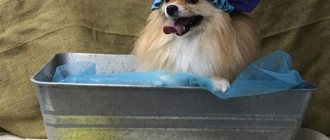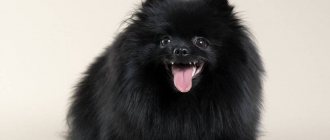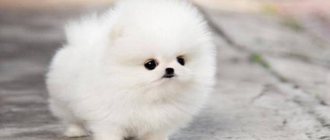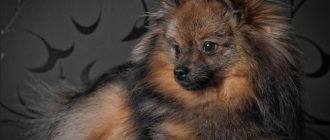1873
Author of the article
Ekaterina Andreeva
Reading time: 4 minutes
A A
Merle Spitz is a rather controversial phenomenon. Some are categorically against dogs of this color, while others consider them incredibly beautiful, and in every possible way advocate for their recognition. Let's try to understand in more detail what it is.
Spitz color: a complete list of all 13 recognized coat colors
Pomeranians are ideal pets for city dwellers with their tiny size and sweet personality.
They are best known for their lively personalities and adorable fluffy coats. However, did you know that the Pomeranian's fluffy double coat can come in over 10 different colors?
There are actually 13 different Pomeranian colors, ranging from pale cream to merle. Perhaps you'll fall in love with their famous orange coat, or maybe you'll love the rare tiger pattern?
Host reviews
A restless, cheerful dog. Runs quickly around the apartment and on the street. Thanks to her, I fell in love with long walks.
My wife bought the dog without my knowledge. She said it was just a Pomeranian. When I went online, I was even upset that the color was not considered a standard. But now, walking down the street, I always meet admiring glances. I'm lucky with my health, but my eyes are different colors.
Got a dog for my birthday. At first I was happy, but then it turned out that the puppy had sore ears and couldn’t see well. Six months have passed and I can’t live without him. He somehow understands me on an intuitive level, what I want from him, where I am and distinguishes between objects. I'm proud of my baby.
Pomeranian Spitz color chart
There are 13 different colors of the Pomeranian recognized by the World Kennel Club.
Some colors, such as beaver and brindle, are less common than the more traditional red, orange, white and black. You can see a complete list of all coat colors in the table below:
| Color | Appearance | Popularity rating |
| orange | Bright orange without black markings. Gradient from light to dark orange. | 1 |
| red | A deep rusty red color with lighter cream fur on the chest. | 2 |
| white | Pure white with no cream or darker markings. | 3 |
| black | Solid black color. | 4 |
| Merle | Splashes of red on a brown base with splashes of white. | 5 |
| Wolf sable | Gray fur with black nose, eye rims, lips and paw pads. | 6 |
| Chocolate | Colors from milk to dark chocolate. | 7 |
| Blue | Silver-gray and dark gray guard hairs. | 8 |
| Cream | Pale fur that looks like a honeycomb. | 9 |
| brindle | With streaks of red, gold, orange and black. | 10 |
| Black and Tan | Fluffy, with black fur on the face and back, with tan on the chest and legs. | 11 |
| Beaver | Light brown in color, reminiscent of a pale cookie. | 12 |
| Tricolor | Black, brown and white pattern. | 13 |
Spitz color chart
What breeds are allowed to have merle coloring?
In most cases, merle-colored dogs are different breeds of shepherd dogs. For other pets it is usually prohibited.
Australian Shepherd (Aussie)
Blue merle Aussies have black eye rims, while merle red Aussies have brown eye rims. The standard also allows black and red wool with a small amount of white areas.
Friendly Australian Shepherds easily get along with cats, hamsters and even geese. To maintain good health, activity is very important for them, so they enjoy playing with children and accompanying their owners on hikes.
Border Collie
The Border Collie standard allows for any variety of merle coloring. The only restriction is the ban on the predominance of white color.
Marbled Border Collies are often confused with Aussies. In fact, this color is rare for them, and the most common coat color is black and white.
Representatives of this breed are the smartest dogs in the world. They understand the meaning of many human words and even learn the names of toys.
Scottish Sheepdog (Collie)
The coat of Scottish Shepherds comes in only 3 types: blue merle, tricolor and sable. The peak of popularity of these charming dogs occurred during the Soviet era.
Collies love to talk, so those who like silence should choose someone calmer. There is no point in weaning them off barking, since this is how they show their love and share their experiences.
Shetland Sheepdog (Sheltie)
The breed is characterized by the following coat colors: blue merle, tricolor, sable, black-brown and black-and-white. The coat itself is soft and thick. Long hairs on the body form a characteristic mane and “pants”.
The Sheltie is almost 2 times smaller than the Collie. Due to their inexhaustible supply of energy, they need regular physical exercise.
Welsh Corgi Cardigan
This adorable little guy is also a shepherd. Unlike the “loaf-shaped” Pembroke, the Cardigan standard is less picky about color. It accepts any variety, including blue merle and brindle.
Due to the popularity of Pembrokes, Cardigans almost disappeared, but in 2016 their numbers were restored. These pets are discreet and docile. They are unfamiliar with the feeling of jealousy, so they easily get along in the same territory with other pets.
Dachshund
Dachshunds come in red, black and brown. The merle on their coat can be combined with any of the listed colors.
Due to their too long body and short legs, dachshunds cannot stand on their hind legs and jump from heights. To sleep together with such pets, you will have to build a ladder so that they can safely climb onto the bed.
German dog
These stately aristocrats have dense and short fur. The standard allows for its coloring in merle, black, blue, fawn and brindle.
Great Danes are the tallest dogs in the world. Keeping them in an apartment is possible only because of their calm nature. But even in this case, the size of the accessible area should be at least 3, and preferably 4 rooms.
Pomeranian Spitz
When dog lovers think of this breed, they think of orange. Breeders call the orange Pomeranian clear orange to distinguish this color from the orange sable. This color was developed by crossing an orange Pomeranian with a sable carrying a pure recessive gene.
These Pomeranians are often puppy-pale. It's a pleasure to watch them ripen and see their color change from pale creamy white to bright orange. Sometimes these puppies' sable coats also turn bright orange.
They typically lack black fur and are a lighter cream color with a gradient of light to dark orange. Orange Pomeranians are very easy to find and are recognized as an acceptable color in their breed standard.
Origin story
The first attempts by breeders to complement the color range of Pomeranians began back in the 1800s. Over time, in addition to tan, sable and other unusual shades, a new color appeared on the scene - merle.
The Merle Spitz is a recently bred species through crossbreeding, which is considered a defect according to the RKF. All over the world, such dogs are not allowed to exhibit, but in America they are bred and officially recognized as the standard. The merle color was developed by crossing a Pomeranian and a merle sheltie.
Spitz merle
Blue merle (blue merle) in adulthood is similar to streaked. The breed is small in number and is not yet one of the most expensive. Bred in Germany by breeder, biologist and geneticist, Professor Kirsten Sanche-Mayer in the Vom Klisterbach nursery. Recognized and registered for the first time by the German club IHR eV
White Spitz
White Pomeranians are pure white with no cream or dark markings.
If you like the look of the Samoyed but want a smaller breed, then this white dog is perfect!
They are born white as puppies and remain this color throughout their lives.
White oranges are white due to the lack of pigment. They do not have the dark pigment melanin (i.e. black eumelanin) that dogs typically have. Due to a lack of pigment, albino animals have red eyes or pink noses. However, a white Spitz is not an albino because its eyes and nose are black.
This adorable Cloud Dog is perfect for anyone who dreams of owning a furry pet and requires the same care, exercise and nutrition as any other color Pomeranian.
What is merle color in dogs?
Marble coloring is a weakening of the main color in certain areas of the coat. From the outside it looks like a lot of chaotic light spots on top of a darker tone. A symmetrical arrangement is rare.
In addition to the fur, the unusual colors affect the eyes. Because of this, heterochromia develops - uneven color of the iris. The eyes become multi-colored or speckled.
Marble on wool is very rare. In many breeds it is equated to marriage, citing a possible danger to the health of the animal.
Black Pomeranian Spitz
This Pomeranian is an adorable solid black color.
Known by fans as creatures of darkness, they still have the signature feisty spirit that we love about the breed.
The black color is created by the E Locus allele gene, which increases the production of black pigment and results in a solid black Pomeranian.
Be careful when taking your black Pomeranian outdoors, as the sun will gradually discolor their fur and result in a reddish-brown coat.
This color is perfect for those who like to wear black clothes as the fur that falls out will remain hidden!
Spitz merle
Merle is a beautiful color pattern because the fluffiness of the Pomeranian's coat shows splashes of red on a brown base with splashes of white. This coloration is very similar to the Australian Cattle Dog. They are often seen as blue or red merles.
Their nose and paws are often variegated shades of pink and black, and their eye color can range from dark brown to blue.
This specimen was bred by mating a merle parent to a black or chocolate Pomeranian.
Make sure your breeder understands the risks associated with breeding Merle dogs. The Double Merle can be very susceptible to deafness or blindness. This is because the double merle gene suppresses certain pigment cells in the iris and cochlea.
This color will wow everyone at the dog park and is perfect for those looking for a splash of color on their pet.
Why is this color considered dangerous?
When the M gene is inherited from both parents, puppies often die while still inside the mother's womb. If they manage to avoid death at the embryonic stage, then the following disorders await them at birth:
- atrophy of the ears or eyes;
- heart diseases;
- low fertility or infertility;
- ophthalmological pathologies (cataracts, night blindness, flattening of the fundus);
- mental disorders, including a tendency to increased aggression.
When breeding spotted animals, it is important to exclude the presence of hidden merle. To do this you need to take a genetic test.
Spitz sable color
The wolf sable Pomeranian is sometimes called the gray sable because it looks very similar to the gray but has black-tipped guard hairs.
This gray variety has a sable pattern, which gives them a black nose, eye rims, lips, and paw pads.
The darkest parts are often the face, back and chest.
Wolf sable is one of the rarest Pomeranian colors and many are mistaken for orange sable. Finding a purebred Wolf Sable Spitz is incredibly difficult, even though the first one was shown in 1901.
The only way to be sure your puppy is a Sable wolf is to take a color gene test.
Price
Blue color is quite rare for a Pomeranian. That's why puppies are more valuable. Blue merle is a gray with varying shades. Prices for animals can reach several thousand dollars.
Merle Spitz puppy
Since the breed is not officially standardized, the merle color is considered a defect, but despite this, due to its rarity, it is highly valued by breeders and owners.
You can buy Merle Spitz in the following nurseries:
- “Tricksy baby (Kherson)”;
- "Merli Sa Tise";
- "From Mrs. Yanina."
Buy such a dog from nurseries to obtain information about the genotype of the parents. This way you will be confident that you are taking a healthy and full-fledged Pomeranian into your home.
Chocolate Pomeranian
Chocolate Pomeranians can range in color from milk to dark chocolate, and their nose and paw pads are often the same silky brown color.
The chocolate color is caused by the B Locus gene, which creates a black pigment that darkens a dog's coat. The mutation dilutes this pigment and results in a chocolate-colored coat.
Like many dogs with darker coats, they do best when not exposed to direct sunlight for long periods of time. Sunlight will redden the coat and make it harder to see the chocolate color.
This dog is a great choice for any owner who wants to walk a teddy bear.
Care and maintenance
The Pomeranian Spitz is an unpretentious dog. What is basic dog care?
Bathing
You should bathe your Spitz once a week using special products for dogs with long hair. The use of balm is mandatory, as it helps protect the coat from environmental influences and moisturize it. After washing, the wool is blotted with a towel and dried with a hairdryer with warm air, combing the wool with a slicker.
Combing
You can comb your orange blossom once every three days. To do this, use a slicker without “droplets” on the teeth and a straight metal comb. Before the procedure, the Spitz's fur is sprayed with a spray for easy combing. During the shedding period, the dog needs to be brushed daily to promptly remove dead hair.
Hygiene procedures
- Nail trimming;
- Cleaning ears and eyes;
- Trimming fur between fingers;
- Teeth cleaning;
All these procedures can be carried out independently, or you can also seek help from a groomer and veterinarian. In the first case, you should not use medications to clean the ears and eyes without a veterinarian's advice. For these purposes, you can find special lotions at the pet store that will not harm the dog.
When purchasing a puppy, you should ask the breeder to clearly demonstrate these procedures. He will tell you how you can accustom your puppy to them.
Daily hygiene for the Pomeranian includes washing the paws and groin after a walk. In dirty weather, belly washing may be necessary.
A haircut
To complete the appearance of the Pomeranian Spitz, they cut it with scissors designed for this purpose. A groomer, a breeder can trim your Spitz, or you can learn to do it yourself. It is important to remember that the Spitz cannot be clipped and its coat cut short (to “Boo”). This will lead to a change in the structure of the wool and a decrease in its practicality. In some cases, alopecia occurs.
Blue Spitz
This Pomeranian is born silver gray and has dark gray guard hair with a blue undercoat.
Blue is a color recognized by the American Kennel Club and is easy to admire.
Blues are bred from two solid-colored parents who carry a diluted gene.
There are health concerns associated with any blue dog because they have a chance of hair loss caused by dilution of the color, leading to hair loss and dry skin.
A blue Pomeranian purchased from a reputable breeder will make a wonderful companion.
Which breeds are prohibited from having merle coloring?
In the breeds listed above, the presence of spots is rarely accompanied by disturbances. In all other cases, everything is much sadder.
Experiments with other dogs were less successful and resulted in many health problems. Because of this, marble was included in their standards as a reason for disqualification.
Pembroke Welsh Corgi
Unlike cardigans, the main color of Pembrokes is red. Sable and black and tan are also acceptable. Merle is not allowed in their standard.
Cheerful Pembrokes have a strong need for human attention. They cannot be kept outside, much less on a leash.
Chihuahua
All colors of Chihuahuas are allowed except merle. Thanks to their compact size, these babies can be kept even in a tiny studio apartment.
Chihuahuas are active, playful and fearless. They can easily bark at a larger dog, ignoring the difference in weight.
French Bulldog
The smooth and shiny coat of French bulldogs lacks undercoat and cannot withstand severe frosts. It comes in white, brindle, beige, fawn and black. Merle is prohibited by the standard, and blue is recognized only by some cynological organizations.
Bulldogs often drool, snore, shed heavily, and suffer from flatulence. Because of this, they are not suitable for clean people and allergy sufferers.
American Cocker Spaniel
Merle is not allowed in American Cocker Spaniels, but all solid colors and colors mixed with white are allowed. The presence of tan marks is possible only on certain parts of the body: cheekbones, paws, the area under the tail, under the eyes, on the inside of the ears and on the chest.
American cockers love to manipulate, but are very vulnerable. A raised tone or dissatisfied intonation can seriously offend them.
Pomeranian Spitz
The FCI does not recognize merle in Pomeranians due to too few individuals. Their number is only a couple of hundred. All other Spitz dogs have 1 of the following 10 colors:
- blue;
- cream;
- sable;
- chocolate;
- white;
- black;
- ginger;
- bicolor;
- black and blue with tan.
Fluffy “bells” are very sensitive to sounds. They bark at any suspicious noise, which often irritates their neighbors.
Yorkshire Terrier
The color of the Yorkie's shiny and silky coat depends on its location. On the head and chest it is red-brown, on the paws it is golden, from the withers to the base of the tail it is silver-blue, and at the very tip of the tail it is dark blue. Merle is prohibited by the standard.
Like the Chihuahua, the Yorkie is suitable for keeping in small apartments. Future owners should know that he is very picky about food.
American Pit Bull Terrier (Pitbull)
The standard allows any existing shades. Unlike most breeds, even the presence of white spots is not prohibited. The only exception is marble.
Pit bulls are good at canine sports and know how to keep their emotions under control. It is difficult to anger them, but with outright provocation they can inflict serious injuries on the offender. For this reason, breeding American Pit Bull Terriers is prohibited in many EU countries.
Do you like the article? 261
brindle spitz
Brindle pattern dogs have stripes of red, gold, orange and black.
The Pomeranian's long coat serves as a canvas for layers of earthy tones.
Brindle is more of a pattern than a color and results in dark stripes. The darkest spots are usually the paws, ears, muzzle and back.
Some are more gray in color and some are brown.
The brindle pattern is caused by the recessive "EE" E Locus genotype.
Each brindle color is different, so you can be sure to get a unique dog.
Black and tan Spitz
The Black and Tan Pomeranian is a color variety with a black and tan pattern. They are fluffy, with black fur on the face and back, and tan on the chest and legs.
Light brown highlights highlight the breed's characteristic pointed eyebrows and give them a sweet and charming appearance. Many have adorable dotted markings above their eyes that resemble eyebrows.
Charming and sassy is the best way to describe this color.
They are very similar in genetics to sable Pomeranians, as they share the same recessive allele.
Black and Tan Pomeranians are unique and look similar to the smaller Rottweiler or Doberman Pinscher.
Anyone who loves the appearance of these breeds but prefers to have a dog that is suitable for apartment living will be delighted with this dog.
Beaver Spitz
The Beaver Pomeranian is light brown in color, resembling a pale cookie. Previously they were called biscuits.
This dog has brown eyes and an all-light brown coat with a lighter cream color on the chest and neck. They come in different shades from brown to beige.
The beaver's diluted chocolate shell is due to a mutation in the diluted gene.
Like the blue Pomeranian, this diluted color can cause alopecia when the color is diluted. This is a genetic disorder that causes hair loss and dry, itchy skin.
Make sure you ask your breeder if they have tested their breeding stock for color dilution hair loss.
13. Tricolor Pomeranian
© shutterstock
The tri-colored Pomeranian is similar to the black and tan, except this dog has the addition of white.
They are known for their black, brown and white patterns.
This color can appear in different ways:
- Some are mostly white.
- Some are mostly dark.
- Some are a mixture of all three.
What this color always seems to have are two brown dotted brows, giving them a sassy expression.
Because each tri-color coat has a different ratio of black, brown, and white, anyone who chooses this variety will always have a unique dog. They are perfect for anyone who doesn't want to settle on one color!
Author of the article: John Woods. John Woods is the founder of Dog Magazine and leads our editorial team as Editor-in-Chief. A member of the Association of Professional Dog Trainers, he has loved dogs since he was 13 years old. John is the parent of Nala, a working Labrador. John also volunteered at several animal shelters where he gained first-hand experience in rehabilitation and non-force positive reinforcement training.
Source
Spitz color standards
The colors of the wool of the German breed and other species are simply amazing in their diversity and unusualness. These little fluffies always attract the attention of others. Dogs have a rather capricious character, and their restless energy is in full swing. If you decide to buy a Spitz, it is important to make the right choice in favor of a color that is standardized, because some of the colors are still not recognized.
For example, according to the standard, a Wolfspitz should only have wolf colors and variations on the theme of gray. Large ones only come in black, brown or white. At the same time, the presence of stains is a non-standard color.
Small dogs have a variety of shades: completely black, white, chocolate, red, cream, marble (zonal gray). In these subspecies, the standard is the presence of two colors, spotting and various rare shades.
Advice. Choose a pet after four months of age, during this period the first molt occurs, and you can see exactly what color the fur coat will be.
All colors of Pomeranian Spitz , which are the standard in the canine association for the breed, are given below with descriptions, names and photographs.
White
Initially, almost all representatives of the breed were snow-white, and only in the 19th century they began to breed dogs of yellow-brown or bright red (orange) color. This became popular among noble nobles, so over time the white color was difficult to find. But breeders were able to protect us from losing such a stunning species.
The main feature of snow-white fur is that according to the standard there should be no inclusions. If you see slight darkening on the ears, most likely, when the molting takes place, the fur will be dark. Also, the presence of black individual hairs on the puppy indicates that dark spots will appear.
When choosing a white Spitz, check his entire pedigree to make sure that all of his ancestors were white. Looking at the parents is not always enough; the pet may show the genes of its grandparents.
Snow white dogs
Black
Coal-black dogs look very impressive. In the sun, their fur shines like a diamond if you provide your pet with proper care and do not cut the fur.
A black Spitz will have this shade not only on the coat, the undercoat and skin should be the same.
Interesting ! Using a black Spitz for mating, you can breed a dog of a different shade.
Small puppies can be brown or slightly brown in color, but after the first shedding the coat becomes a uniform, deep color.
Ginger
There are red and orange Spitz dogs. This standard differs only in color intensity. Puppies are born orange. For this type, the standard is the presence of fur of varying intensity on individual parts of the body: chest, muzzle, paws.
If you want to opt for a red-haired baby, look behind the ears. Most often, when it sheds, the color will be the same.
Red pet
Brown
Chocolate colored dogs are quite an unusual coloring. These dogs have coat shades ranging from light chocolate to deep brown. This standard gives preference to darker and more saturated colors. The color of the eyelids, lips and nose can match the fur coat, which is acceptable according to the standard. The color does not change after molting, so you can choose a baby of the desired color at a young age.
Brown handsome man
Sable
These are two-ton dogs that have light roots and dark hair tips. The colors can be beige, gray and orange of different saturations. Color intensity may vary.
Sable color
Party color
The main feature of this type is the presence of a basic tone and interspersed with other colors. The base is always white, and inclusions can be anything, for example, chocolate, red or black. Most often you can find a black and white Spitz.
It is ideal when the specks are distributed evenly over the animal’s body, and the muzzle is painted symmetrically. This is what is valued at exhibition events. An unsuccessful option is coloring, when there are practically no colored spots. In this situation, it will not be possible to win the exhibition.
Party-color dogs
Spotted
The peculiarity of this color is that the base color can be anything, but the inclusions should not be gray, red or black. The spots should be evenly distributed over the animal's body. Such a Spitz will look advantageous against the background of others, which are much more common, due to its unusual coloring.
Spotted handsome
brindle
The brindle color is a little reminiscent of sable, but the significant difference is the presence of stripes, like a tiger. They are brown, less often orange or black. These dogs look amazing and resemble little tiger cubs.
brindle amazing dog
Black and tan
Black and Tan Spitz have a deep black base tone, and the face, chest and legs can be sable or orange.
This color is recognized almost from birth. There are light spots under the eyes, at the base of the muzzle and on the paws.
Interesting ! An interesting fact is that as a Pomeranian grows older, the tan shade of a Spitz can change and become brighter or redder.
Zone gray
These dogs have an unusual coat that resembles a wolf's, which is why zone gray is often called the wolf color. The fur covering the animal's body is silver-gray. The muzzle and ears are darker, and a clear black outline appears around the eyes. This line from the eyes reaches the dog's ears.
The undercoat can be cream, orange or ash gray. The fur around the neck and shoulders is much lighter than the main shade, the tip of the tail is very dark, almost jet black.
Zone gray color
Cream
It is impossible to determine the shade of a cream Spitz immediately after birth. This color will definitely be visible after the dog sheds for the first time. Most often, such puppies are born snow-white, beige, and sometimes white with yellow spots.
If your dream is to become the owner of a cream pet, carefully study its entire pedigree. These dogs come in two shades: rich cream and cool cream. Saturated is sometimes called warm, while cold is difficult to distinguish from white in appearance.
Cream color is very rare
Blue
Blue Spitz, perhaps the most recognized color standard, is the rarest and has a high price. It’s not just that, in the photo, blue-colored Spitz dogs, just like in life, look amazingly impressive. Merlene (merle) color is sometimes found among this standard, but it is a deviation from the norm.
Due to the combination of gray-blue shades, the animals look very unusual, and due to their rarity, they are prized at exhibition events.
Blue Merle Dog - Expensive Dog
Merle Gene - Everything You Need to Know About the Merle Factor!
The variety of shades of our dogs' coats is truly impressive. While some dog breeds always have only one coat color, there are dogs that come in an extremely varied range of coat colors.
The merle gene comes into play. But what is it - a factor or a gene? Does it affect all breeds or does it affect some more than others? And how is the color of the coat related to the health of the dog? Let's touch on the topic of the "merle factor" in a little more detail.
What does merle factor mean?
The merle factor is, in fact, a mutation of a gene in a dog - more precisely, the color of the dog's coat. It causes a disruption of the silver gene, which in turn leads to a dilution of the dog's original coat color. In this case, the coat and skin are colored unevenly, differently than in dogs without the merle gene - in dogs with the merle color ("merle") there is a pigmentation disorder. Since this disorder is distributed unevenly throughout the dog's hair, a "ragged" color effect occurs, often dogs with merle coloring appear mottled. Merle dogs often have blue or even white eyes. This is also associated with pigmentation disorders - the eyes may even be of different colors, for example, one eye is blue and the other is white.
A Brief Overview of Merle Dog Genetics
As already mentioned, a mutation occurs in the silver gene, more precisely, the gene for the silver locus (Pmel17), located on chromosome CFA10. However, the merle gene does not lighten all areas of the coat, but only those that contain eumelanin. Those areas that contain exclusively pheomelanin remain unaffected.
If a mixed-heritage dog with the merle gene is mated with a dog that does not have the gene, statistically the expected litter will be 50% merle puppies and 50% normal puppies.
How is the merle gene inherited?
With the merle color, an allele (a pair of genes) takes part in inheritance, in which dominance is incomplete, and consists of the merle factor “M”, as well as the monocolor gene “m”:
“mm” – clear color (mostly red or brown)
“Mm” – heterozygous merle (mixed heredity)
“MM” – homozygous merle (pure heredity – with merle syndrome)
Merle factor is inherited in an autosomal intermediate manner.
In this photo there is a blue merle Australian Shepherd on the left and a red merle on the right.
Along with the basic forms "M" (merle) and "m" (not merle), there are also so-called Cryptic Merles ("mysterious merle") ("Mc"), Atypical Merles ("atypical merle") ("Ma") and Halequin Merles (“Harlequin Merle”) (“Mh”).
The insidiousness of the “mysterious merle” is that such dogs are difficult to recognize, at least by coat color. The only thing that can help here is a test that will show whether the merle factor is present or not.
The case is completely different with the Harlequin Merle color. Dogs with Mh tend to have particularly light coats. This may affect the entire body or a small area. A distinctive feature is that the clarified area has a silver color, almost white.
A dog with an "atypical merle" tends to have a less spotted coat.
However, in contrast to the "mysterious merle", her coat is lighter.
The differences between individual merle color types are not easy to spot, and it is especially difficult for uninformed owners to recognize a dog with the merle factor.
What does a merle dog look like?
Admittedly, merle-colored dogs are something special and they look really cute – but what makes them stand out so much from their one- or two-colored cousins? Let's look at the colors of our dogs in more detail.
The color pigment eumelanin is essentially black – but not in dogs with the merle gene. Due to pigmentation disorders, all parts of the hair, skin, and eyes become lighter. As a result, the wool, which should be black, acquires different color nuances. These include, first of all, gray and brown. There are many intermediate shades, such as silver-gray, copper or even blue-gray. As a result, those places that should have been black become white and spots appear. These places are not always the same size. These can be small or quite large spots. Each dog with the merle gene has a completely unique color that cannot be influenced in any way.
Health Consequences in Merle Dogs
Not only are skin, coat and eye color affected by the merle factor, but health problems can also occur. It is worth noting that dogs that received the gene from one parent are healthy in most cases. Dogs whose parents both carry the merle gene often have various problems.
First of all, merle colored dogs may suffer from deafness. Sometimes a dog only has one-sided hearing loss, but the problem can affect both sides.
Along with this limitation, the eyes of dogs with merle syndrome are also affected. For example, delamination of the membrane of the eye is possible, and there may also be severely reduced eyes or deformed pupils. Many puppies are born blind. Along with the organs of vision, problems such as, for example, deformation of the heart may arise. Possible degeneration of the skeletal system or deformation of the genital organs.
Merle puppies with pure heredity suffer from increased activity and often do not survive to sexual maturity.
Merle dogs of mixed heritage
Although the risk is significantly lower, mixed merle dogs may have some disadvantages. Thus, it turned out that merle dogs with only one merle allele often suffer from balance disorders. The reason lies in the dog's inner ear. There are so-called melanocytes. Melanocytes are naturally highly pigmented, which can also be altered if the merle gene is present.
Most mixed merle dogs are not completely deaf, but most often suffer from hearing loss, which is only noticeable upon direct examination.
According to statistics, the life expectancy of dogs with merle color of mixed heredity is also significantly lower than that of completely healthy relatives.
Dog Breeds with Merle Factor
The Australian Shepherd is perhaps the most famous carrier of the merle gene. Especially many dogs of this breed exhibit this color and the associated gene mutation. Therefore, when choosing a dog of this breed, you must carefully read the information about the breed and choose only a reliable breeder.
However, there are other breeds that can have the merle color.
- Sheltie
- collie
- Border Collie
- dachshund
- German dog
- welsh corgi cardigan
- chihuahua
- pit bull terrier
- Cocker Spaniel
- Catahoula leopard dog
- Pyrenees Shepherd
- pomeranian spitz
- norwegian hound
- Beauceron
How can I tell if my dog is a merle factor carrier?
There are laboratories that can test and find out if your dog is a carrier of the merle factor. A simple genetic test is performed using a swab from the dog's mouth. You can consult your veterinarian, who will also be able to assist with the test. However, it is necessary to take into account that all tests are paid.
Are you planning to get a four-legged friend and are not sure whether the chosen puppy is a carrier of the merle factor? The first authority, of course, should be the breeder. Based on information about the puppy's parents, documents and the results of possible preliminary studies, it should already be clear whether the dog has the merle factor. Particular care must be taken if there are no documents - then you can agree with the seller to conduct research or refuse the purchase altogether.
Is it advisable to purchase a dog with the merle factor?
Of course, this decision, like many others, is made at your discretion. Breeding pure merles should be avoided as otherwise you expose a lot of dogs to suffering. It should also be noted that the popularity of such dogs is primarily due to their unusual color. Many owners don't even realize that this wonderful appearance is associated with serious health problems for their pet.
There are also owners who deliberately choose a dog with a merle color. The decision is yours. It is important to familiarize yourself with information about such a mutation in advance so that you do not unknowingly support the breeding of such dogs.
Disqualifying faults
RKF admitted a number of serious violations that will lead to disqualification from the exhibition event. These include spots on the coat of any color other than white. The presence of white marks on the tips of the legs or chest is not a fundamental reason to disqualify an animal.
An equally serious violation is a black nose in any type of Spitz except chocolate. The brown one may have a nose that matches the color of the fur.
If the exhibition is held in winter, a lighter nose on an orange, beige or cream Spitz is not considered a disqualifying fault. This is due to the fact that in winter their nose always becomes lighter.
Owner reviews
Our dream of having a Pomeranian in the house came true two years ago. A handsome red-chestnut Barry, bred by American breeders, appeared in the apartment. He is of the bear type, so he never ceases to touch even in adulthood, and his fur color changes depending on the lighting.
We bought a puppy for exhibitions, we couldn’t wait until four months to make sure of its pure snow-white fur, and look further into the pedigree than mom and dad hadn’t guessed. As a result, we cannot participate in exhibitions because disqualifying spots have appeared. At first it was offensive, but then they calmed down. We still love our little bundle.
Source











